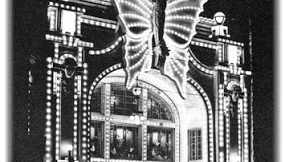Lost to History: Film and Television We May Never See Again
So there I was, watching G.I. Joe: Retaliation for no other reason than I was too lazy to change the channel. When it was over, I thought to myself, “There is two hours I will never get back.” Then I realized that there are some people (mostly under the age of 13) that really liked the film and what a bummer it would be if the film didn’t exist anymore and could never again be watched by the people that might like it. When something is lost, no matter how unappreciated it is, it is a loss for everyone.
As a species, humans are wonderfully contradictory about how we value our past. We venerate what we should forget and forget what we should venerate. So it is no surprise to me that many great works of humankind are lost to history. The fact that we do not know the final resting place of Egyptian Pharos or Biblical figures is no real shock as these people all lived thousands of years ago. The lost Shakespeare plays (Love’s Labour’s Won and The of History Cardenio –the latter attributed to Shakespeare but often disputed) are certainly regrettable, but understandable losses. Certainly lost works of art from the entire span of history are sad but inevitable facts of the passage of time. Lost forever due to the ravages of time and nature (The Colossus of Rhodes) or destroyed by the shortsightedness of people (Assumption of the Virgin by Bartolomeo), these reminders of what we have lost or failed to protect and treasure should have been warnings to us as a species to honor our past.
Alas no. Humans have never failed to forget or destroy what we once loved. Worse yet, we destroy then later regret the loss of something we failed to appreciate at the time. What I am really amazed by is how many NEW things, such as films and television programs, we have lost. The entire history of film is less than 125 years and the history of television is half that, so we are not talking about something lost in the mists of time for thousands of years. But still we find ourselves mourning the loss of these ‘new’ things.
A ‘lost’ film or television program is defined as one that no known complete copy exists in archives or in private collections. With something like film and TV it is particularly remarkable to have a ‘lost’ item given the sheer number of copies made at the time of release. Sadly, many times we only know of these lost pieces of work because of contemporary accounts or existing secondary material such as still-photos or publicity materials.
There may be clips from otherwise ‘lost’ films but they are usually an exception rather than the rule. Usually if a film is ‘lost’, it is lost in its’ entirety. In many of these cases the only reason we know of the films is from the production artifacts remaining like scripts or costumes but usually they are the only remnants left of what may have been an amazing film. The number of lost productions is so great that there cannot be an exact number. The AFI and other groups have estimated that as much as 90% of the silent era is missing, probably forever. Even into the 1940s, there are still far too many instances of lost films. TV programs suffered this fate as well into the 1970s. The saddest part is that many classic moments of the then-young medium are likely never to be seen again.
Reasons for the losses

There are several reasons films and TV programs are lost in time and none of them simple or obvious. The most common reasons are chemical decomposition and fire. Films made between the 1890s and 1930s were done on nitrocellulose or ‘nitrate stock’, made from camphor wood bi-products. Basically they are like plasticized wood. Unfortunately, this makes the stock subject to actually rotting away with age when not properly stored (in a cool, dry well ventilated place), in much the same way that fallen logs will rot away on the forest floor. When stock is not stored properly, heat and moisture combine to slowly dissolve the stock. (Technically nitric acid is released as a catalyzing agent that eventually reduces the film to a powdery crud so violently flammable that even immersion in water will not always extinguish the flames). Even without the chemical decomposition issue, nitrate film stock is incredibly hazardous and was known to burst into flames in the projection booth during showings. Special safety precautions and training for projectionists were needed and there are even a few notable instances of people dying in the theaters as a result of the fires. Two particularly tragic fires in the late 1920s killed over 100 people, clearly showing the hazards of this awful material. Ironically, the job of Projectionist became romanticized in popular culture of the time because of the hazardous nature of the occupation. Most film studios incurred damage from improper storage of film stock. Even when films were stored correctly after their initial showings, they were not safe. Both MGM and Warner Brothers lost large portions of their film libraries due to warehouse fires.

The next most common cause of the film loss was much more violent and senseless. While neglect caused by a plentiful lack of ‘give a crap’ was very common, there are many more examples of deliberate destruction. Movies were rarely seen to be of any value after their initial theatrical exhibition, remember there was no home video or TV syndication market back then. Many were destroyed just to save on storage costs while others were recycled for the silver content of the film stock. Sometimes the destruction of film was seen as a part of the process. Charlie Chaplin was one of many filmmakers that would routinely BURN his own rushes (now called dailies) as they were never intended to be seen by the general public. (Imagine a Jackie Chan film without the outtakes during the credits) If you’re familiar with Chaplin movies then you can imagine what artistry may have been lost.
The apathy toward these films was universal but on occasion the desire to forget them was just as deliberate as their destruction. Many filmmakers are almost forgotten today because the world at large wanted to forget. Roscoe “Fatty” Arbuckle is only remembered by serious fans of silent film today because of the way his career ended. After a scandal involving three very messy and public trials for the death of a dancer after a party (William Randolph Hearst was quoted as saying “We sold more papers because of the Arbuckle trial than we did over the sinking of the Lusitania.”), Arbuckle was effectively ‘black-listed’ despite being acquitted of all charges and never worked in Hollywood again. This distain carried over into his films and the studio allowed them to be forgotten. Sadly, several are now lost entirely. Quite a fate for a star second only to Chaplin in box office sales at the time.
In an even stranger situation filmmakers would sometime withhold the films for years after their initial release. Studios do this it and it is not considered that unusual, as anyone familiar with Disney’s ‘vaulting’ of classic films should be aware. It is really just an artificial method of creating a demand for the product and ‘special’ anniversary re-issues but when filmmakers retain control of their works, it is odder still. Harold Lloyd was largely forgotten and many of his films thought to be lost since they had not been seen in decades, all because he refused to allow their re-issues. Until the 1970s, many silent era fans were unaware of him at all then his estate finally began allowing his work to be released. Now many of his classic films are available in their original, uncut forms on DVD. My personal ‘favorite’ of lost films, Humor Risk the very first Marx Brothers film, which was destroyed by the brothers themselves because they did not like the final product (Or it was lost accidentally, depending on what Groucho remembered each time he was asked). Had it survived, it would be the earliest filmed example of the Marx Brothers and their only silent film.
Early sound films were chucked in the bin when it was realized that the soundtracks were missing. Many early ‘talkies’ had soundtracks that were separate from the physical film (now when a film print is struck, the soundtrack information is a part of the print as a strip along the side of the frames or a part of the digital file in the case of digital systems). The Vitaphone company created a system called ‘sound-on-disc’ for films that was essentially a phonograph record (for you young’uns out there, those are the big black CDs in the dusty basement at your grandma’s house) that was played along with the movie. The problem arose when the sound disc was lost but the film wasn’t. When the fact was discovered that the talkie no longer had any sound, the chance it would be destroyed increased dramatically. Often the studios just threw up their hands and called it a loss.
There are many films by well-known stars of the day that just no longer exist. Many of the early Mary Pickford films are gone, lost in a fire, while others she made simply vanished over time. Virtually the entire catalog of Theda Bara’s films (including the supposed masterpiece Cleopatra) is gone. The original ‘vamp’ made nearly 40 films, most of which were destroyed in a fire at the Fox film vaults in the late 1930s. Several of the early classic John Ford westerns are also now considered lost, forever robbing us some of the works of a master of his craft. HUGE stars of the day and even stars well remembered today have films that are now considered gone. The Barrymore family (Hollywood’s first family dynasty now represented by Drew Barrymore) of the silent era and early talkies have several films that are lost as are many of the films of Douglas Fairbanks. Other artists’ films that have suffered similar fates include Walter Mitty, Gloria Swanson, Lon Chaney, baseball legend Babe Ruth, Laurel & Hardy and there are even a few early John Wayne films that are now lost forever. Yes, you read that right, there are John freaking Wayne films missing!

Many modern films, despite not being on nitrate stock, were in danger of being at least partially lost. One terrifying and incredibly stupid example is Star Wars. When Lucasfilm went into the vaults to do the THX re-master for the 1997 reissue (the first version of the ‘special editions’), they found a badly degraded original negative of the film due to improper storage. Had they waited just a few more years there potentially would have been no original negative to strike high quality prints from, which means no Star Wars in the theaters and no nice looking copies of the film for home video.
If you will allow me a brief sort of digression…

There is one aspect of classic Hollywood that also needs help to survive. As important as the classic films are, the palaces they were seen in are every bit as endangered. Before television helped draw people away from cinemas and before we all moved out to the suburbs, the movie palace was such vital and important part of everyday lives, many towns had more movie theaters than bars. In the town I live in, there were 12 large movie houses within a 6 block area of the downtown. This was in the 1920s when the population of the entire town was less than 20,000. Now in the same town with a population just under 100,000, there is one theater in the same area remaining and only one other in the entire town.
It is not merely that there are fewer places to see films, it is the beauty and quality of the places that has suffered as well. In the era of the giant multiplex, it is hard to picture a single screen, 800 seat theater, harder still to think of that theater as a place of beauty. Victims of apathy, greed, damage and time, these wonderful places are even more endangered than the classic films screened there. If there are any remaining classic theaters in your area, support them! Places of beauty and history, these are something we can never regain if they are lost.
OK, now back to our story…

When it comes to television programs the reasons for missing shows are even more awful. In some early cases, live TV simply was not recorded; the technology for video tape still being widely unavailable or cost prohibitive. Even once the broadcasts were recorded (either for delayed broadcast or just because of someone’s whim), much was either not saved or eventually wiped (deliberately erased) so that the videotape could be used again. This is not like my dad recording over an episode of Magnum P.I. I was saving when I was a kid (the end of the world at the time, I assure you), but rather the complete erasure of a part of history.
Television broadcasts from all over the world and the entire early history of the medium are considered lost. The BBC was one of the worst offenders as the budgets were determined by the National Trust and the license fees which created the need to be more economical and reuse the tapes. Most glaring for many modern fans is the lost Doctor Who serials from the eras of the first two actors to play the role (see a little further down for more info on this). Dad’s Army, Top of the Pops, The Morecambe & Wise Show and many others are lost, possibly forever.
In the US, the missing episodes seem to me to be of greater historical importance. Almost everything broadcast by the short-lived Dumont Television Network is lost, much of it airing originally before widespread use of videotape. Almost everything from the Tonight Show’s first years, up to 1972 is missing due to wiping. Some of the Super Bowls are missing broadcast footage and Super Bowl II is missing entirely! Most daytime soap operas from the early years are missing huge numbers of episode and many classic game shows were either never saved at all or have since been lost.
Even when something can be saved, it is not a perfect solution; even digital storage creates loss of quality. A poor digital restoration can be almost as bad as no restoration at all since restoring and archiving a film can often require the alteration of the film itself. There are more and more good restorations of older silent films though and since many of us only know these classics from poor quality duplicates of duplicates, seeing some of the restorations has been a real treat.
A cause for at least SOME hope…
Every few years a lost treasure is rediscovered in a basement, attic or film vault. Long lost films really do resurface and while we will never see many of these treasures again, there is a growing list of rediscovered gems and the continuing hope for more…
One of the most important films ever made is Fritz Lang’s Metropolis, which is considered to be the first feature length film of the science fiction genre. It also happens to be the most expensive silent film of its era. While it has existed in numerous forms and has never really been lost, it has not existed in its original premier cut in generations. Originally trimmed by (according to varying reports) as much as an hour for its release in various countries, the surviving portions of the film have never really made much sense as the footage removed was a subplot that tied much of the rest of the narrative together and provided the film its heart. Over the last decade, several sections of film have been found and reincorporated into the original film, including a nearly complete section of the previously edited portions that was found in Argentina in 2008. This amazing film now exists for everyone in a version that is almost the same as audiences would have seen it in 1927 and the available Blu-ray presentation, while not perfect, is a wonderful example of how to restore a very damaged film.
Several of the Nazi propaganda films by visionary director Leni Riefenstahl have been rediscovered over the years after being thought deliberately destroyed. I cannot stomach much of the content of these films but the director’s utter brilliance cannot be disputed. (We’ll just leave the politics out of it) If you have not seen the documentary about her called The Wonderful, Horrible Life of Leni Riefenstahl, treat yourself.
Just recently a 35 mm print of a long lost Orson Welles silent film, Too Much Johnson, was rediscovered in an Italian warehouse. The last known copy of the film was believed to be destroyed in a 1970 fire that also destroyed Welles’ home in Spain. A restoration of the film has supposedly been completed and will soon be seen by the public.
After Richard Burton’s death, the actor’s personal copy of his version of Hamlet was discovered among his effects. All copies were thought to have been deliberately destroyed years earlier.
Some of the few lost Chaplin films, Cruel, Cruel Love and A Thief Catcher were discovered after half a century of being lost. Several other silent films from Fatty Arbuckle, Buster Keaton, Mabel Normond and Lon Chaney Sr have all been rediscovered, many in recent years as a greater effort to bring the issue of lost films has been mounted.
By way of a segue into TV, filmmaker Ed Wood’s lost TV program Final Curtain was recovered recently and was shown at the 2012 Sundance festival. There has been a fair amount of rediscovered TV in recent years, notably the original pilot episodes of Star Trek and I Love Lucy but also many other shows thought long gone.
To end with a little extra hope that may (hopehopeHOPE!!!!) be rewarded soon, there are rumors of the recent recovery of a huge number of the lost Doctor Who serials; possibly as many as 90! Included in a large haul are several other series with recovered episodes like Dad’s Army. Yes, they are just rumors but for now they are very persistent ones. In some cases, these rumors have been quietly ‘confirmed’ by people ‘in-the-know’ and have begun to gain momentum as we approach the 50th anniversary of the program. The possibility of seeing these for the first time since they were originally broadcast is a tantalizing one to be sure and I really do hope that these rumors prove to be much more substantial as we approach the anniversary date of November 23rd.
So lets raise a toast that we will be rewarded for our hope by more lost treasures being recovered as the years continue.
What do you think? Leave a comment.











Loved reading this article. very informative and I learnt a lot from reading it. I remember reading somewhere that it is thought that 90% of films made before 1930 are considered lost. It is mind-boggling. What’s worse is when there are still photographs of lost films. it makes the loss seem even more tragic.
Really fascinating article. I learnt a lot from it.
I just watched Metropolis Remastered and thought it was so good! I really wish there were many more in the same tune as that one and others that I could be watching.
Metropolis has a very deep spiritual feel. Director Fritz Lang is one of the most influential directors of his time. If you like his visual style (he is one of the great auteur directors responsible for the film noir cycle) I would recomend the movie M, The Big Heat and his Mabuse movies.
M is an utter masterpiece. Well worth a look.
Are you aware that 50% of all films and 80% of all music human kind has created is considered lost for good? Crazy.
Great article that speaks to the significance of film preservation.
Enjoyed every bit of this. Glad that journalists are still informing our young generation about these productions.
While in US films were thrown away, in Russia, apparently, they were often put in storage. Quite recently, LIC found 10 of these films in Russia that we believe were lost. They have been digitally restored since.
Have a look here: http://www.youtube.com/watch?v=zVJ7cC9nxr8
The Russian archives is proving to be a real treasure trove. No ‘major’ lost film recovered yet, but thjere are really some interesting ones that have turned up.
Unfortunately, they are in the same boat when it comes to deteriorating stock and the eventual disintigration of the product.
I’m a superhero geek so when I found out that “The Phantom Athlete” was the second superhero film created, I wanted to give everything to watch it. Or enter a time machine back to late 1910s Italy and watch it there.
I have not heard of this one, so I will have to do some looking.
I also am comics, and superhero centric, so this would be a neat find.
I’ve never given this topic more than passing thought before – now I’m interested! As someone who keeps a diary, likes to write all my ideas down and backs up everything religiously it really appeals to me that we should preserve television and film, even if it is deemed ‘unworthy’ at its time of release. Also, those movie palaces are absolutely beautiful – a real shame they’ve been lost.
You should check out a site called cinema treasures. They track theaters classic and not so classic all over the world. All you need to do is look up where you live now or an nearby city and you will be amazed at what has been lost. The town I live in has had and lost nearly 60 theaters in its history. And that is a toen with less than 100 thousand people today!
It’s crazy to think that film can perish, even with all of our technology. Great article, but it also made me quite sad for the future ha ha. But yes, it is very interesting that so much has been lost and will continue to be lost.
BEst stuff i’ve read all week!
Really enjoyed this one Taylor, thanks for writing it. It bothers me to think that some movies I love were almost lost forever. If you think of the disdain Woody Allen has for Manhattan…he could have destroyed that. I couldn’t go on with life if I didn’t have Manhattan to delude me into thinking that when I’m 42 young women will find me attractive because of my brain (*note* – sarcasm. Young women already find me attractive. *Note 2* – also sarcasm). I kind of have the fear that in, say, 50 years time, my favourite films will have disappeared for whatever inexplicable reason, and I’ll never see them again. That kind of paranoia is the reason I own two copies of Synecdoche New York, and why I didn’t get rid of my DVD copies of Lost in Translation, Annie Hall, Eternal Sunshine and countless other when I updated to blu ray.
With home video involved, complete loss–barring global horror/zombie apokolips is not likely. 🙂
The sad thing is as a culture we still treat our history like junk. Our children have no imagination and cannot fathom a time without video games, let alone anything ever happening of importance that predates thier own memory.
There are days a really despair for the species.
Solid history.
In weird way I feel like it affords film an even greater power. The idea that it still contains an inherent impermanence and ability to be lost/decay. I find it astonishingly easy to buy a film and then go almost a year before I watch it because I feel like my copy is always going to be there. There’s something magic in making film feel ephemeral again so thanks for this.
There’s also an interesting question in there about whether or not an artist has a right to destroy his/her own work. If a film maker/author wants destroy all copies of something they’ve created do they have the right to do so? (I mean philosophically, obviously if Woody Allen destroyed a film he worked on he’d probably be in breach of contract to the studio who paid him etc. but hopefully you get what I mean)
Ephemeral, yes. But still kind of sad.
The creator’s rights thing is something that has been on my mind of late.
May end up being an article soon…
HariMacKinnon’s point about film’s “inherent impermanence” speaks to our particularly romanticized expectations for film (and by extension television). Unlike other artistic/archival media, film uniquely promises to thwart “the ravages of time” through its capacity to record otherwise transitory moments and beings. Of course we intellectually accept the premise that all film is subjectively constructed; but the “magic pictures” offer a deeply seductive version of immortality, or at least the promise of such. What I find so compelling about Taylor Ramsey’s essay is its disenchanting effect: Ramsey astutely reminds us of film’s fragile materialism (not to mention the fragility of the culture that has built up around film). And I agree with HariMacKinnon: Ramsey’s argument does cause me to reappraise my own DVD collection. Thanks for a great exchange of ideas here–I look forward to your thoughts about the rights of the creator to intervene in this process of preservation.
Film that’s viewed in movie theatres, as films are really meant to be viewed, are a much bigger treat then seeing them on a big TV or elaborate home theatre system. I have a strong preference for many of the older films, such as ones in the 1960’s, and some 1980’s and 1990’s films, to many, if not most of what’s coming out nowadays in the way of movies.
Many movie theaters have had to face the choice of having DVD projection, or going dark, due to today’s technology, but, in any event, I’d rather see a film in a movie theatre than on TV, whenever possible.
FathomEvents.com and Turner Classic Movies, have gotten together to play a number of the older films as periodic national re-releases into selected movie theatres, which is great. Having at least 3 independent movie theatres left in my general area helps, as well.
Re: the photo with the description, “ Roscoe ‘Fatty’ Arbuckle and Charlie Chaplin in a rare appearance together. From the film The Rounders.”, this looks like a clever parody of the Laurel & Hardy films. This is rather fitting considering that Charlie Chaplin was Stan Laurel’s comedic partner before Oliver Hardy.